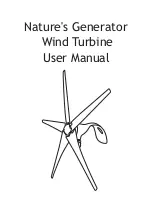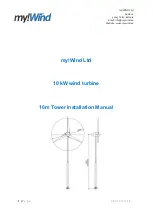
AIR 40, AIR Breeze, AIR 30, AIR X MARINE and AIR SILENT-X are trademarks of Primus Wind Power 2013 Primus Wind Power Inc.
AIR Owner’s Manual
3-CMLT-2020-A
30
AIR WIND TUBINE OPERATION
Operational Summary
AIR converts wind to rotational motion which turns the alternator and pro-
duces electrical power. The voltage is regulated for battery charging and
integrated controls prevent overcharging of the batteries, allowing the
turbine to continue charging until the battery reaches a full state of charge.
AIR also uses integrated controls to protect the wind turbine from extreme
wind damage.
AIR incorporates a three-phase brushless permanent magnet alternator
and microprocessor controlled electronics to optimize its power produc-
tion capability. The microprocessor continuously adjusts the loading of the
alternator to keep the turbine operating efficiently in most wind regimes.
The result is high power production, high blade efficiency, and lower blade
noise.
POWER MODE (Charging)
During charging mode, the turbine’s LED is continuously illuminated.
AIR charges batteries when:
•
The battery state of charge is above the minimum threshold (e.g. 10.5
volts on a 12 volt system) but below the voltage set point (set at the fac-
tory at 14.1V for 12 volt turbines but field changeable via the potenti-
ometer)
•
Sufficient wind is available
Charging continues until:
•
The battery voltage set point has been reached (BATTERY REGULATION
FLOAT/STOP)
•
The wind is excessively high (OVERSPEED PROTECTION), approximately
16 m/s (35 mph) or greater
•
The wind resource decreases such that the wind turbine RPM’s diminish
below 420 (LED will turn off)
OVERSPEED PROTECTION:
In gusty or sustained high winds greater
than 16 m/s (35 mph), AIR enters overspeed protection where the blades
come to a near stop (approximately two revolutions per second). Depend-
ing on the code revision level for your turbine, the turbine stops the blades
(near stop) until restart is initiated. If the wind is still high or gusty, the cy-
cle is repeated until the wind speeds drop below 16 m/s (35 mph). Depend-
ing on your code revision, the LED may blink roughly 3 times per second or
once every 2 seconds. Contact Primus Wind Power for further LED varia-
tions between AIR turbine models/voltages.
Overspeed protection is stressful on the turbine. Primus Wind Power rec-
ommends taking measures to protect the turbine in excessively high wind
situations.
BRAKE MODE:
AIR may be placed in brake mode by directly shorting the
turbine positive and negative wires together or by using a stop switch. The
stop switch first disconnects the turbine from the battery and then shorts
the positive and negative wires. In very strong winds the blades may rotate
slowly even with the switch activated. If a high wind event is in the forecast
(gusts greater than 23 m/s (50 mph), it is recommended to consider placing
the turbine in brake mode.
AIR 40 Differences: AIR’s integrated controls allow it to generate energy in
wind speeds up to 16 m/s (35 mph). Over 16 m/s (35 mph), the turbine blades
drop in speed to control heat build-up. Eventually the turbine may shutdown
completely to avoid excessive heat build-up in high wind conditions.
AIR 30 Differences: AIR 30 enters overspeed protection in gusty or sus-
tained winds over 16 m/s (35 mph) and remains there (as described
above) until the wind speeds drop below 16 m/s (35 mph).
































